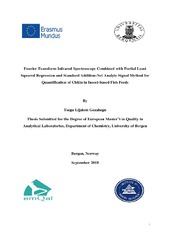| dc.description.abstract | Fourier transform infrared spectroscopy (FTIR) spectroscopy is a rapid and non-destructive technique applied with little or no sample preparation step. This work presents the use of FTIR spectroscopy combined with partial least squares (PLS) regression and standard addition based on the net analytical signal (SANAS) methods of multivariate calibrations to predict the quantity of chitin in fish diets. Besides, the attenuated total reflectance (ATR)-FTIR spectroscopy characterization study was conducted on chitin powders purified from shrimp and black soldier flies (BSF) exhibited close similarity in all infrared (IR) vibrational bands of the spectrum. The estimation accuracy of PLS model was based on the root mean squared error of cross-validation (RMSECV), root mean squared error of prediction (RMSEP) and correlation coefficient (R2) values. Precision (coefficient of variation, 5.64%), linearity, limit of detection (LOD = 0.026 % w/w) and limit of quantification (LOQ = 0.084 % w/w) were also estimated to validate the PLS multivariate calibration model. The correlation coefficient (R2) and RMSECV between the predicted and measured percentages of chitin calibration sets were 0.982 and 0.220. RMSEPs for purified, raw, and demineralized BSF insect prediction samples were 20.7, 11.2, 1.53 % chitin (w/w) respectively. The % of chitin (w/w) predicted for purified, raw and demineralized BSF insect samples were 66.8, 31.9 and 16.9. In addition to this, 8.90, 8.60 and 10.51 % chitin (w/w) were estimated in three random insect-based fish diet test samples. Throughout the study, second-derivative Savitzky-Golay (15-point window size) third order polynomial expression was applied as a spectra data pre-processing method. The net analyte signal (NAS) of analyte component is obtained by projecting the spectral data to the subspace orthogonal to the other components (interferents) in the mixture. The NAS vector of the analyte in the unknown sample and standard spiked with varying concentrations of the analyte were calculated. Plots of Euclidean norms of NAS vectors against the spiked concentration of standards have been done. The analyte in the unknown sample is estimated by extrapolating at the opposite of abscissa intercept. This linear standard addition plot is similar to the univariate calibration model which made it very easy to interpret the results. Several sources of chitin and types of fish feed were investigated. The correlation coefficients for all calibration models were above 0.9900, with the exception of purified chitin from black soldier fly (0.9641). The predicted weight percentage of chitin obtained in purified and raw black soldier fly powders were 9.32 and 1.66 whereas in one fish feed sample without insect added and other three insect-included fish feed samples were estimated, 1.07,1.65, 3.12 and 3.82 % chitin (w/w) respectively. The percentage of chitin quantified in the purified and raw black soldier flies by the use of net analyte signal method were not in agreement with the acid detergent fiber method. | en_US |
